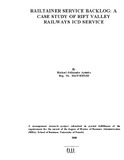| dc.contributor.author | Ayimba, Michael O | |
| dc.date.accessioned | 2013-05-15T06:24:19Z | |
| dc.date.available | 2013-05-15T06:24:19Z | |
| dc.date.issued | 2008 | |
| dc.identifier.uri | http://erepository.uonbi.ac.ke:8080/xmlui/handle/123456789/22763 | |
| dc.description.abstract | This study's objective was to look into the causes of the railtainer backlog
at the port of Mombasa. This is because the backlog is affecting the quality
of the service and off take rate of rail bound containers from the Port. The
backlog problem was there during the time of Kenya Railways and has
continued to persist during Rift Valley Railways. A number of writers have
attempted to get to the root causes of container backlog. According to
Mongelluzo (2005) the handling of larger ships results in greater uneven
flow of containers as more containers arrive during port calls. This uneven
flow strains the port and railroad operations. Jackson (2005) says that the
international marine container volumes have surged over the last several
decades, but the ports and their supporting container distribution networks
have struggled to increase capacity to match this expansion. Kulich (2004)
asserts that the capacity problem is exacerbated by the fact that railroad and
truck carriers serving the ports also experience severe capacity shortages.
A case study research design was used and the population of study
comprised of 75 staff (i.e. forty five from Rift Valley Railways and thirty
from Kenya Ports Authority). Stratified random sampling was used to
select a sample of forty percent of the population. The study used a semi
structured and undisguised questionnaire that had both open and closed
ended questions to gather primary data. The questionnaire was
administered on a "drop and pick later" basis and a follow-up made to
ensure a high rate of response.
A total of thirty questionnaires were administered but only twenty eight
questionnaires were filled and returned, this translates to ninety three
percent response. There was a fifty eight percent awareness that there
existed a targeted dwell time for containers at the port after discharge from
ships while eighty nine percent of the respondents were aware that there
were delays in loading of containers. The study confirmed that there was a backlog of rail bound containers at the port. The backlog had various
causes most of which were within RVR's control. The solution to minimize
the backlog lies in RVR managing the variables within its control. | en |
| dc.description.sponsorship | University of Nairobi | en |
| dc.language.iso | en | en |
| dc.subject | Rift Valley Railways (RVR) | en |
| dc.subject | ICD service | en |
| dc.subject | Railtainer | en |
| dc.subject | Service backlog | en |
| dc.title | Railtainer Service Backlog:a Case Study of Rift Valley Railways Icd Service | en |
| dc.type | Thesis | en |
| local.publisher | School of Business, University of Nairobi | en |

